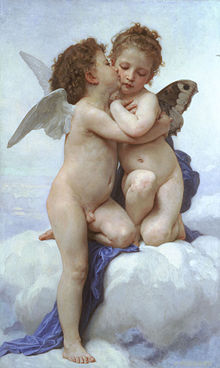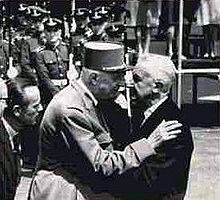- Cheek kissing
-
 "L'Amour et Psyche, enfants" Amor cheek kissing Psyche. Oil on canvas by William-Adolphe Bouguereau. 1890
"L'Amour et Psyche, enfants" Amor cheek kissing Psyche. Oil on canvas by William-Adolphe Bouguereau. 1890
Contents
Cheek kissing is a ritual or social gesture to indicate friendship, perform a greeting, to confer congratulations, to comfort someone, to show respect, or to indicate sexual or romantic interest.
Cheek kissing is very common in Southern, Central and Eastern Europe, the Mediterranean, the Middle East and Latin America. It is not as common in English-speaking Canada and the United States, Asia and Northern Europe. However, there are some exceptions in North America, including ethnic neighborhoods, such as Italian, French, or Hispanic neighborhoods, as well as Quebec, Louisiana and Miami.
Soviet and other eastern European communist leaders often used to greet each other in this fashion on public and state occasions. Nowadays in Eastern Europe male-female and female-female cheek kissing is a very common greeting between friends, especially younger than 35 years old. Male-male cheek kissing is less common.
Depending on the local culture, cheek kissing may be considered appropriate between a man and a woman, a parent and a child, two women, or two men. The latter is socially accepted in South Eastern Europe and in some countries of the South Western Europe, Latin America[citation needed] and the Middle East, and in Europe generally it is becoming increasingly common especially among the young. It may, however, bring up associations with homosexuality in Asia, some places in Latin America, US and the northern part of Europe.
In a cheek kiss, both persons lean forward and either lightly touch cheek with cheek or lip with cheek. Generally the gesture is repeated with the other cheek, or more, alternating cheeks. Depending on country and situation, the number of kisses is usually one, two, three or four. Hand-shaking or hugging may also take place.
Cheek-kissing is used in many cultures with slightly varying meaning and gesture. For example, cheek-kissing may or may not be associated with a hug. The appropriate social context for use can vary greatly from one country to the other, though the gesture might look similar.
North America
In the United States and Canada, the cheek kiss may involve one or both cheeks. According to the March 8, 2004 edition of Time Magazine, "a single [kiss] is [an] acceptable [greeting] in the United States, but it's mostly a big-city phenomenon."[1] Occasionally cheek kissing is a romantic gesture.
Cheek kissing of young children by adults of both sexes is perhaps the most common cheek kiss in North America. Typically it is a short, perfunctory greeting, and is most often done by relatives.
Cheek kissing between adults, when it occurs at all, is most often done between a man and woman who know each other well, such as between relatives or close friends. In this case, a short hug (generally only upper-body contact) may accompany the kiss. Also common is cheek kissing between two women who know each other or are related. Likewise, hugs are common but not required. A hug alone may also suffice in both of these situations, and is much more common. Particularly in the Southeast, elderly women may be cheek-kissed by younger men as a gesture of affection and respect.
Immigrant groups tend to have their own norms for cheek kissing, usually carried over from their native country. In Miami, Florida, an area heavily influenced by Latin American and European immigrants, kissing hello on the cheek is the social norm. In parts of New England influenced by Franco-American or French Canadian cultures, cheek kissing is popular.
In Quebec, cheek kissing is referred to, in a popular language, as "un bec" (donner un bec). People of the opposite sex usually kiss once on each cheek. Cheek kissing between women is also very common, though sometimes men will refrain. However cheek kissing between men is becoming more and more common, especially among young people. Two people introduced by a mutual friend may also give each other un bec.
Latin America
In Latin America, cheek kissing is a universal form of greeting between a man and a woman or two women. It is not necessary to know a person well or be intimate with them to kiss them on the cheek. In fact, when some Latin American (Brazilians, Argentines, Chileans, Peruvians, Ecuadorians and Colombians for instance) people are introduced to someone new, they usually greet them with a cheek kiss if the person being introduced to them is a member of the opposite sex or two women. If the person is a complete stranger, no kissing is done. Also in Colombia, one-kiss-only is usually performed, mostly on the right cheek. A cheek kiss can be accompanied by a hug or in more formal occasions a handshake.
As with other regions, cheek kissing may be lips-to-cheek or cheek-to-cheek with a kiss in the air, the latter being more common.
Cheek-kissing between two men is usually seen as a sign of homosexuality or femininity in the most conservative countries, except father-son cases and very rarely, close friend kissing. In the Southern Cone countries of Chile, Argentina and Uruguay it is common (almost standard) between male friends to kiss "a la italiana", i.e. football players kiss each other to congratulate or to greet. This kind of greeting can be awkward to, say, a Mexican trying to shake hands with a new Argentine friend who is trying to kiss him.
Also like in Southern Europe, in Argentina and Uruguay men kissing men is common but it varies depending on the region, occasion and even on the family.
Southern Europe
Cheek kissing is a standard greeting throughout Southern Europe between friends or acquaintances, but less common in professional settings. In general, men and women would kiss and women will kiss women. Men kissing men varies depending on the country and even on the family, in some countries men will kiss men; in others only men of the same family would consider kissing. It may also depend on the part of a country and the occasion.
Greece is an example of a country where cheek kissing highly depends on the region and the type of event. For example, in most parts of Crete, it is common between a man and a woman who are friends, but is very uncommon between men unless they are close relatives. In Athens it may be commonplace between close friends of both sexes when meeting or departing. It is uncommon between strangers of any sex, and it may be considered offensive otherwise. It is standard for children and parents, children and grandparents etc., and in its "formal" form it will be two kisses, one on each cheek. It may be a standard formal form of greeting in special events such as weddings.
However, in Portugal and Spain, usually, men only kiss women (even with strangers). In Portuguese families men often kiss men, but the handshake is the most common salutation between them. However, men kissing may occur in Spain as well particularly when congratulating close friends or relatives. Cheek to cheek and the kiss in the air are also very popular. Hugging is common between men and men and women and women; when the other is from the opposite sex, a kiss may be added.[citation needed]
In the former Yugoslavia cheek kissing is also very commonplace, with your nationality being ascertainable by the number of kisses on each cheek. Typically, Croats and Bosniaks will kiss once on each cheek, for two total kisses, whereas Serbs (be they from Bosnia, Croatia, Serbia or Montenegro) will kiss three times, typically starting at the right cheek. In Serbia and Montenegro, it is also not uncommon for men to kiss each other on the cheek three times as a form of greeting, usually for people they have not encountered in a while, while male-female and female-female kissing is also standard.
Western Europe
In France, where the custom is called "faire la bise", the cheek kiss came under scrutiny during the swine flu epidemic of 2009.[2] A popular French joke states that you may recognize the city you are in by counting the number of cheek kisses as it really varies across the country. It is also an alleged excuse to steal a few more kisses to a girl to say something like "Chez nous, c'est quatre" after having already kissed twice ("where I come from, it's four!"). Some girls will even push the joke by answering "mais chez nous c'est huit!" ("and where I come from, it's eight!").
In the Netherlands cheek kissing is a common greeting between relatives and friends (throughout the country, but slightly more so in the south). Generally speaking, women will kiss both women and men, while men will kiss women but refrain from kissing other men, instead preferring to shake hands. As is usual in several western European countries like in neighboring Belgium (among Flemings but not Walloons), in Switzerland (among all ethnic groups) and also in France (fairly common throughout the country, but more so in the north towards Belgium and in the east towards Switzerland), a cheek kiss consists of three consecutive kisses.
In Wallonia, one of the two French-speaking regions of Belgium, cheek kissing is a common greeting including between two men. People generally give only one kiss, using the right cheek.
Although cheek kissing is not as widely practised in the United Kingdom as in other parts of Europe, it is still commonplace. A more common greeting would be a hug. It is mostly used as a greeting, but can also be offered as a congratulation or as a general declaration of friendship or love. Cheek kissing is acceptable between parents and children, family members (though not often two adult males), couples, two female friends or a male friend and a female friend. Cheek kissing between two men who are not a couple is unusual but socially acceptable if both men are happy to take part. It is widely regarded as inappropriate to cheek-kiss a stranger as a greeting.
Asia
In the Philippines, cheek kissing is a common greeting. Called a "beso" (Spanish for "kiss"), the Philippine cheek-kiss is a cheek-to-cheek kiss, not a lips-to-cheek kiss. The cheek-kiss is usually made once (right cheek to right cheek), either between two women, or between a woman and a man. Among the upper classes, it is a common greeting among adults who are friends. Among the rest of the population, however, the gesture is limited to relatives. In general, Filipinos who are introduced to each other for the first time do not cheek-kiss unless they are related.
In Macau, very few of the residents are of Portuguese descent, and thus cheek kissing is popular in most situations as in Portugal among themselves.
In certain communities in Indonesia, notably the Manado or Minahasa people, kissing on the cheeks (twice) is normal among relatives, including males.
Some parts Western Asia (the Middle East) also practice cheek-kissing (see below).
In parts of Central, South, and East Asia with predominantly Buddhist or Hindu cultures, or in cultures heavily influenced by these two religions, cheek-kissing is uncommon and may be considered offensive.
Middle East
Cheek kissing in the Arab world is relatively common, between friends and relatives. Cheek kissing between males is very common. However, cheek kissing between a male and female is usually considered inappropriate, unless within the same family; e.g. brother and sister, or if they are a married couple. Some exceptions to this are Lebanon and some of the more liberal Arab countries, where cheek kissing is a common greeting between unrelated males and females in most communities, and the Lebanese custom has become the norm for non-Lebanese in Lebanese-dominated communities of the Arab diaspora. Normally in Lebanon, the typical number of kisses is three: one on the left cheek, then right, and then left between relatives.
Cheek kissing in Turkey is also widely accepted in greetings. Male to male cheek kissing is considered normal in almost every occasion, but very rarely for men who are introduced for the first time. Some men hit each others head on the side instead of cheek kissing, possibly as an attempt to masculinize the action. Cheek kissing between women is also very common, but it is also very rare for women who are introduced for the first time. A man and a woman could cheek kiss each other for greeting without sexual connotations only if they are good friends or depending on the circle, the setting, and the location like in big cities.
See also
- Greeting habits
- Holy kiss
- Kiss
- Paschal greeting
- Public display of affection
- Salute
References
- ^ Billinson, Jennifer (March 8, 2004). "How many Kisses?". Time. http://www.time.com/time/magazine/article/0,9171,598580,00.html. Retrieved December 4, 2009.
- ^ "France facing 'la bise' ban over swine flu fears". telegraph.co.uk. 2009-09-08. http://www.telegraph.co.uk/news/worldnews/europe/france/6155768/France-facing-la-bise-ban-over-swine-flu-fears.html. Retrieved 2010-06-12.
Gestures Friendly gestures Air kiss · A-ok · Cheek kissing · Dap greeting · Elbow bump · Eskimo kissing · Fist bump · Hat tip · High five · Hongi · ILY sign · Namaste · Sign of the horns · Shaka · Thumbs signal · WaiFormal gestures Salutes Bellamy salute · Nazi salute · Raised fist · Roman salute · Scout sign and salute · Three-finger salute · Two-finger salute · Vulcan salute · Zogist saluteCelebratory gestures Finger counting Obscene gestures Head motions Other gestures Air quotes · Anasyrma · Crossed fingers · Facepalm · Finger gun · Gang signal · Hand-rubbing · Jazz hands · Kuji-in · Laban sign · Loser · Mudra · Pollice verso · Puppy face · Shrug · Sign of the Cross · Varadamudra · V signRelated Categories:- Gestures
- Greetings
- Parting traditions
Wikimedia Foundation. 2010.


